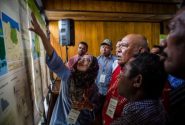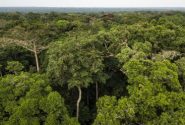By Angela Dewan
The world is looking for ways to reduce carbon emissions, alleviate poverty, feed a booming population and continue economic growth at the same time. As aspirations to achieve these goals intensify, so too does pressure on forests.
Among the most threatened are tropical forests, with different sectors competing for their share. Environmentalists want to protect them to sequester carbon; palm oil and paper companies want to grow plantations on them; scientists are looking at how to adapt them to new climates; and communities want to use them for livelihoods.
Scientists and policy-makers are working hard to collaborate on ways to allow economic development alongside forest conservation. The idea that they can go hand-in-hand is a positive one, but in reality, it is not always that simple, according to one scientist. In a session titled “Improving livelihoods through research and action in biodiversity-rich tropical forest landscapes”, Patrice Levang, a scientist at the Center for International Forestry Research, said that in one particular national park on Sumatra Island in Indonesia, government’s will have to carefully consider whether the economic gains from small coffee farms is worth the loss of forest.
The Bukit Barisan Selatan National Park in Lampung province is protected by law and is world heritage listed by Unesco. Yet 20 percent of the land is held by encroachers and 11 percent by squatters, taking over 1,687 hectares.
“It is very difficult to protect the forest if the people continue to clear and cultivate the land at this rate,” Levang said.
Most of the squatter families come from Java Island and harvest coffee in the park. “They do it for economic reasons. … But many of them say they don’t really want to be farmers. The younger especially want to move to the city and get jobs. Those that get a good education tend to do that,” he said.
In other parts of the world, researchers have been looking at the relationship between poverty and the forest. Gill Shepherd of the International Union for Conservation of Nature looked at the spatial relationship between forests and poverty, and set out to prove or debunk long-held beliefs in the area.
“For the last 15 years we have known that forests contribute to subsistence, and some income and employment to local livelihoods,” said Robert Fisher, Shepherd’s colleague presenting the research. “But it was thought forests were of value only to bridge seasonal gaps and hard times. Recently we have learned more about types of poverty; about how major dependence on forests can be; and about how hard it can be to get out of poverty if you live in the wrong place.”
Her research on tropical forest communities in Tanzania, Ghana and Papua showed a direct link with access to markets and roads with cash wealth. In the most remote areas, poverty alleviation strategies should not just revolve around cash wealth, according to Shepherd.
“We must make sure that we do not accidentally increase livelihood vulnerability through forest protection schemes that do not take into account their existence,” Shepherd’s presentation concluded.
What this discussion showed was that there is no umbrella rule at which to balance conservation and development, and policy aiming to strike this balance will have to carefully crafted, at times on a case-by-case basis.
There may be economic incentives for squatters to keep growing coffee, but if they want to relocate to the city, perhaps governments can support them. If remote communities do not measure their livelihoods with cash, perhaps decision-makers should tailor policy to other values. Innovative policy will require better communication between forest communities and governments.
PERSONS QUOTED IN THIS BLOG DO NOT NECESSARILY REPRESENT THE VIEWS OF CIFOR
We want you to share Forests News content, which is licensed under Creative Commons Attribution-NonCommercial-ShareAlike 4.0 International (CC BY-NC-SA 4.0). This means you are free to redistribute our material for non-commercial purposes. All we ask is that you give Forests News appropriate credit and link to the original Forests News content, indicate if changes were made, and distribute your contributions under the same Creative Commons license. You must notify Forests News if you repost, reprint or reuse our materials by contacting forestsnews@cifor-icraf.org.













